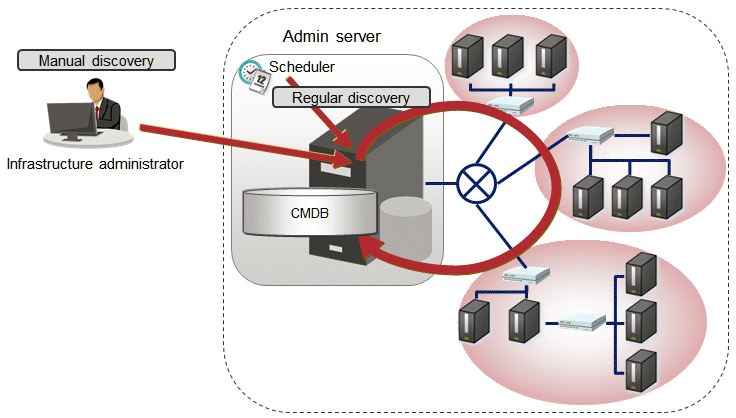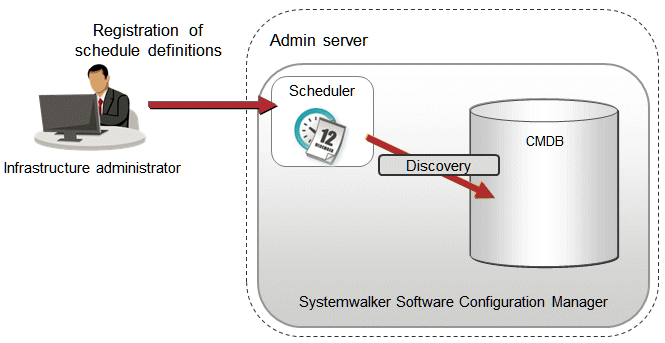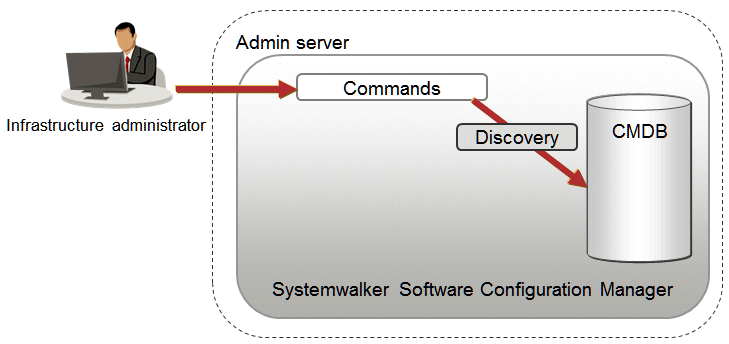"Discovery" is a function that collects configuration information for business servers and registers it in the configuration management database (CMDB).
The configuration information collected by the discovery function is registered in the CMDB as configuration items (CI).
Figure 2.1 Overview of the discovery function

Hardware/virtual environment configuration to be collected
The following hardware/virtual environment configuration information can be collected using the discovery function:
The configuration information of the virtual environments is collected from VMware vSphere ESXi or OpenStack.
Device | Item | Example |
|---|---|---|
Chassis body Fujitsu PRIMERGY BX400 S1, BX600 S2/S3, BX900 S1/S2 | Product name | BX900 |
Serial number | AA1234567890 | |
Firmware version(*1) | 5.32 | |
Blade server Fujitsu PRIMERGY BX620 S3 - S6, BX920 S1 - S4, BX922 S2, BX924 S2 - S4, BX960 S1 | Slot number | 1 |
Vendor name | FUJITSU | |
Product name | PRIMERGY BX920 S1 | |
Serial number | BB1234567890 | |
CPU Type | Xeon | |
Frequency | 1995 MHz | |
Quantity | 2 | |
Memory size | 4096 MB | |
Firmware version(*2) | 551 | |
BIOS version(*2) | 3D41 | |
OS name(*3) | VMware ESXi 5.1.0 build-1157734 |
*1: On PRIMERGY BX400 S1 and BX600 S2/S3, the firmware version cannot be discovered.
*2: On PRIMERGY BX620 S3 - S6, the firmware version and BIOS version cannot be discovered.
*3: Only when the version of the mounted hypervisor is VMware vSphere ESXi 5.1 or later can discovery be performed.
Device | Item | Example |
|---|---|---|
Fujitsu PRIMERGY RX100/RX200/RX300 S6 or later, RX1330/RX2520/RX2540 M1 or later IBM System x3550 M4 HP ProLiant DL320e Gen8 v2 | Product name | PRIMERGY RX300 S7 |
Serial number | CC1234567890 | |
CPU Type (*2) | Intel(R) Xeon(R) CPU E5-2609 v2 @ 2.50GHz | |
Frequency(*3) | 2500 MHz | |
Quantity | 2 | |
Memory size | 4096 MB | |
OS name(*1) | VMware ESXi 5.1.0 build-1157734 |
*1: Only when the version of the mounted hypervisor is VMware vSphere ESXi 5.1 or later can discovery be performed.
*2: On PRIMERGY RX100/RX200/RX300 S6 the CPU type cannot be discovered.
*3: On IBM servers and HP servers, the frequency cannot be discovered.
Hypervisor | Type | Item | Example |
|---|---|---|---|
VMware vSphere ESXi | VM host information | OS name | VMware ESXi 5.1.0 build-1021289 |
CPU core count | 8 | ||
MAC address | 60:EB:69:07:F3:xx | ||
IP address | 192.168.1.12 | ||
VM guest information | Virtual machine name | VM001 | |
OS name | Microsoft Windows Server 2012 (64-bit) | ||
CPU core count | 2 | ||
Frequency (GHz) | 1.0 | ||
Memory size (GB) | 2.0 | ||
MAC address | 60:EB:69:07:D3:xx | ||
IP address | 192.168.10.122 |
Hypervisor | Type | Item | Example |
|---|---|---|---|
KVM (QEMU) | VM host information | CPU core count | 8 |
IP address | 192.168.1.12 | ||
VM guest information | Virtual machine name | VM001 | |
OS name | rhel 6.6 | ||
CPU core count | 2 | ||
Frequency (GHz) | 1.0 | ||
Memory size (GB) | 2.0 | ||
MAC address | 60:EB:69:07:D3:xx | ||
IP address | 192.168.10.122 |
Software configuration information collected
The following software configuration information can be collected using the discovery function:
Resource | Linkage product/linkage function | |||||||||
|---|---|---|---|---|---|---|---|---|---|---|
ServerView Resource Orchestrator | Microsoft Windows Server Update Services (WSUS) | yum(Yellowdog Updater Modified) | UpdateAdvisor (middleware) | Solaris | ||||||
System configuration information | Resource information for the physical or virtual servers that make up the system (IP addresses and operating system information only) | Y | Y (*1) | Y (*1) | Y (*1) | Y (*1) | ||||
Tenant information | Y | - | - | - | - | |||||
L-Platform information | Y | - | - | - | - | |||||
Patch information | Windows patches | Information about Windows patches released by Microsoft | OS patch information | - | Y | - | - | - | ||
Physical /virtual Windows servers where the patches can be applied | - | Y | - | - | - | |||||
Information about the OS patches that have already been applied to the physical/virtual Windows servers that make up the system | - | Y | - | - | - | |||||
Linux patches | Information about Linux patches (RPM packages) released by the Red Hat Network or the Fujitsu website | Information about OS patches (RPM packages) | - | - | Y | - | - | |||
Physical/virtual Linux servers where the patches can be applied | - | - | Y | - | - | |||||
Information about the OS patches (RPM packages) that have already been applied to the physical/virtual Linux servers that make up the system | - | - | Y | - | - | |||||
Solaris OS Patches | Solaris OS patch (SRU) information released on the Oracle or Fujitsu website | OS patch (SRU) information | - | - | - | - | - | |||
Applicable physical or virtual Solaris servers | - | - | - | - | - | |||||
Information about the OS patches (SRU) that have already been applied to the physical and virtual Solaris servers that comprise the system | - | - | - | - | Y | |||||
Middleware patches | Fujitsu middleware patches released on the UpdateSite | Fujitsu middleware patches | - | - | - | - (*2) | - | |||
Physical/virtual servers where the patches can be applied | - | - | - | - (*3) | - | |||||
Information about the Fujitsu middleware patches that have already been applied to the physical/virtual servers that make up the system | - | - | - | Y | - | |||||
Software information | Information about the Fujitsu middleware products that have already been installed on the physical/virtual servers that make up the system | - | - | - | Y | - | ||||
Y: Can be collected.
-: Cannot be collected.
*1: IP addresses only
*2: This information is not collected by the swcfmg_patch_updateinfo command. Information about Fujitsu middleware patches is registered in the CMDB by executing swcfmg_fjmwpatch_update (Fujitsu Middleware Patch Registration command). Refer to the Reference Guide for details.
*3: swcfmg_fjmwpatch_update (Fujitsu Middleware Patch Registration command) registers authorization information about applicable physical or virtual servers in the CMDB. Refer to the Reference Guide for details.
The timing of discovery
Discovery is performed at the following times:
Regular discovery
Discovery is executed periodically according to a schedule.
Manual discovery
Discovery is manually performed by the infrastructure administrator executing a command.
With regular discovery, the latest configuration information is collected according to a schedule that the infrastructure administrator has defined in advance.
Figure 2.2 Regular discovery

The infrastructure administrator collects the latest configuration information by executing the command to perform discovery.
Figure 2.3 Manual discovery
